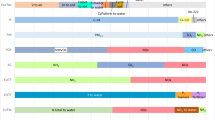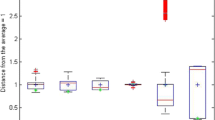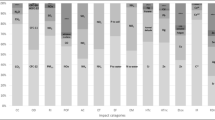Abstract
When LCA practitioners perform LCAs, the interpretation of the results can be difficult without a reference point to benchmark the results. Hence, normalization factors are important for relating results to a common reference. The main purpose of this paper was to update the normalization factors for the US and US-Canadian regions. The normalization factors were used for highlighting the most contributing substances, thereby enabling practitioners to put more focus on important substances, when compiling the inventory, as well as providing them with normalization factors reflecting the actual situation. Normalization factors were calculated using characterization factors from the TRACI 2.1 LCIA model. The inventory was based on US databases on emissions of substances. The Canadian inventory was based on a previous inventory with 2005 as reference, in this inventory the most significant substances were updated to 2008 data. The results showed that impact categories were generally dominated by a small number of substances. The contribution analysis showed that the reporting of substance classes was highly significant for the environmental impacts, although in reality, these substances are nonspecific in composition, so the characterization factors which were selected to represent these categories may be significantly different from the actual identity of these aggregates. Furthermore the contribution highlighted the issue of carefully examining the effects of metals, even though the toxicity based categories have only interim characterization factors calculated with USEtox. A need for improved understanding of the wide range of uncertainties incorporated into studies with reported substance classes was indentified. This was especially important since aggregated substance classes are often used in LCA modeling when information on the particular substance is missing. Given the dominance of metals to the human and ecotoxicity categories, it is imperative to refine the CFs within USEtox. Some of the results within this paper indicate that soil emissions of metals are significantly higher than we expect in actuality.

Similar content being viewed by others
References
Bare J (2011) TRACI 2.0: the tool for the reduction and assessment of chemical and other environmental impacts 2.0. Clean Technol Environ Policy 13(5):687–696. doi:10.1007/s10098-010-0338-9
Bare JC (2012) Tool for the reduction and assessment of chemical and other environmental impacts (TRACI), Software name and version number: TRACI Version 2.1, User’s Manual. US EPA
Bare J, de Udo Haes HA, Pennington DW (1999) Life cycle impact assessment sophistication. Int J LCA 4(5):299–306
Bare J, Hofstetter P, Pennington DW, de Udo Haes HA (2000) Life cycle impact assessment midpoints vs endpoints—the sacrifices and the benefits. Int J LCA 5(6):319–326
Bare J, Norris G, Pennington DW, McKone T (2003) TRACI—the tool for the reduction and assessment of chemical and other environmental impacts. J Ind Ecol 6(3):49–78
Bare J, Gloria T, Norris G (2006) Development of the method and U.S. normalization database for life cycle impact assessment and sustainability metrics. Environ Sci Technol 40(16):5108–5115
Dijkman TJ, Birkved M, Hauschild MZ (2012) PestLCI 2.0: a second generation model for estimating emissions of pesticides from arable land in LCA. Int J LCA 17(8):973–986. doi:10.1007/s11367-012-0439-2
Environment Canada (2010) The National Inventory Report–1990–2008–Greenhouse gas sources and sinks in Canada part 3. United Nations Framework Convention on Climate Change. http://unfccc.int/national_reports/annex_i_ghg_inventories/national_inventories_submissions/items/5270.php. Accessed 26 Feb 2012
Environment Canada (2012) Air pollutant emission summaries and trends—criteria air contaminants (National: 1985–2010). National pollutant release inventory. http://www.ec.gc.ca/inrp-npri/default.asp?lang=en&n=0EC58C98. Accessed 14 May 2013
European commission—joint research centre (2010) International reference life cycle data system (ILCD) handbook—specific guide for life cycle inventory data sets, 1st edn. Institute for Environment and Sustainability, Luxemburg
Gandhi N, Diamond ML, Van de Meent D, Huijbregts MAJ, Peijnenburg WJGM, Guinée J (2010) New method for calculating comparative toxicity potential of cationic metals in freshwater: application to copper, nickel, and zinc. Environ Sci Technol 44(13):5195–5201
Grube A, Donaldson D, Kiely T, Wu L (2011) Pesticides industry sales and usage—2006 and 2007 market estimates biological and economic analysis division office of pesticide programs office of chemical safety and pollution prevention, U.S. Environmental Protection Agency, Washington, DC 20460
ISO (2006) ISO 14044-International standard environmental management—life cycle assessment—requirements and guidelines. ISO 14044. International organisation for standardisation, Geneva, Switzerland
Jolliet O, Margni M, Charles R, Humbert S, Payet J, Rebitzer G, Rosenbaum R (2003) IMPACT 2002+: a new life cycle impact assessment methodology. Int J LCA 8(6):324–330. doi:10.1007/bf02978505
Laurent A, Lautier A, Rosenbaum RK, Olsen SI, Hauschild MZ (2011a) Normalization references for Europe and North America for application with USEtox™ characterization factors. Int J LCA 16(8):728–738. doi:10.1007/s11367-011-0285-7
Laurent A, Olsen SI, Hauschild MZ (2011b) Normalization in EDIP97 and EDIP2003: updated European inventory for 2004 and guidance towards a consistent use in practice. Int J LCA 16(8):401–409. doi:10.1007/s11367-011-0278-6
Lautier A, Rosenbaum RK, Margni M, Bare J, Roy P-O, Deschênes L (2010) Development of normalization factors for Canada and the United States and comparison with European factors. Sci Total Environ 409(1):33–42
Rosenbaum RK, Bachmann TM, Gold LS, Huijbregts MAJ, Jolliet O, Juraske R, Koehler A, Larsen HF, MacLeod M, Margni M, McKone TE, Payet J, Schuhmacher M, van de Meent D, Hauschild MZ (2008) USEtox—The UNEP-SETAC toxicity model: recommended characterisation factors for human toxicity and freshwater ecotoxicity in life cycle impact assessment. Int J LCA 13(7):532–546. doi:10.1007/s11367-008-0038-4
Suh S (2009) Eco-efficiency in industry and science. In: Suh S (ed) Handbook of input-output economics in industrial ecology, 2nd edn. Springer, New York
Swiss Centre for Life Cycle Inventories (2012) Ecoinvent centre. http://www.ecoinvent.ch/. Accessed 12 May 2012
US census bureau (2011) International data base,. US census bureau http://www.census.gov/population/international/data/idb/country.php. Accessed 12 Dec 2012
US Department of Agriculture-Natural Resources Conservation Service (2006) model simulation of soil loss, nutrient loss and soil organic carbon associated with crop production. http://www.nrcs.usda.gov/wps/portal/nrcs/detail/national/technical/alphabetical/nra/?&cid=nrcs143_014128. Accessed 15 Apr 2012
US Environmental Protection Agency (2010a) Inventory of U.S. greenhouse gas emissions and sinks: 1990–2008. United Nations Framework Convention on Climate Change. http://unfccc.int/national_reports/annex_i_ghg_inventories/national_inventories_submissions/items/5270.php. Accessed 14 Dec 2011
US Environmental Protection Agency (2010b) TRI explorer—Toxics release inventory 2008. US Environmental Protection Agency. http://iaspub.epa.gov/triexplorer/tri_release.chemical. Accessed 14 Dec 2011
US Environmental Protection Agency (2011) National Emissions Inventory (NEI). US Environmental Protection Agency. http://www.epa.gov/ttnchie1/net/2008inventory.html. Accessed 14 Dec 2011
US Environmental Protection Agency (2012a) Basics of TRI Reporting. US Environmental Protection Agency. http://www.epa.gov/tri/triprogram/bussinesscycle/index.html. Accessed 18 Dec 2012
US Environmental Protection Agency (2012b) High Production Volume Information System. US Environmental Protection Agency. http://www.epa.gov/hpvis/index.html. Accessed 14 May 2013
U.S. life cycle inventory database (2012) national renewable energy laboratory. https://www.lcacommons.gov/nrel/search. Accessed 19 Nov 2012
Weber L, Zsak G, Reichl C, Schatz M (2010) World-mining-data, vol 25. World Mining Congress, Vienna
Wenzel H, Hauschild MZ, Alting L (1997) Environmental assessment of products: methodology, tools and case studies in product-development, vol 1. Chapman & Hall, London
Acknowledgments
The authors would like to acknowledge Anne Lautier for providing the Canadian emission inventory. We also acknowledge Steelcase for permission to use this existing Answer Workstation model as leverage for demonstrating the application of updated NFs for TRACI.
Disclaimer
Although EPA contributed to this article, the research presented was not performed by or funded by EPA and was not subject to EPA’s quality system requirements. Consequently, the views, interpretations, and conclusions expressed in this article are solely those of the authors and do not necessarily reflect or represent EPA’s views or policies.
Author information
Authors and Affiliations
Corresponding author
Electronic supplementary material
Below is the link to the electronic supplementary material.
Rights and permissions
About this article
Cite this article
Ryberg, M., Vieira, M.D.M., Zgola, M. et al. Updated US and Canadian normalization factors for TRACI 2.1. Clean Techn Environ Policy 16, 329–339 (2014). https://doi.org/10.1007/s10098-013-0629-z
Received:
Accepted:
Published:
Issue Date:
DOI: https://doi.org/10.1007/s10098-013-0629-z




